"Taobao Rules" |
Before the change | After the change |
Article 57: The abuse of information is an act of users who fail to publish goods or information in accordance with these rules and other management content published by Taobao (including but not limited to rules, specifications, category management standards, industry standards, etc.) and hindering the rights and interests of buyers, including the following circumstances: (I) Advertising information; (2) The information does not match the actual situation; (III) Repeat information; (IV) Inconsistent product elements (V) Price cheating; (VI) Special requirements of the industry. If the seller has any of the above circumstances, Taobao will take measures such as warning, removing the product, deleting the product, deleting the store, removing the store, removing the store, removing the store decoration, restricting the store decoration release permissions, closing the store, reducing the right to search for a single product, blocking the store search, blocking the store, deducting the points, etc. depending on the severity of the circumstances. | Article 57: The abuse of information is an act of users who fail to publish goods or information in accordance with these rules and other management content published by Taobao (including but not limited to rules, specifications, category management standards, industry standards, etc.) and hindering the rights and interests of buyers, including the following circumstances: (I) Advertising information; (2) The information does not match the actual situation; (III) Repeat information; (IV) Inconsistent product elements (V) Avoid information ; (VI) Special requirements of the industry. If any of the above situations exist, Taobao will take measures such as removing the products, deleting the products, deleting the store, removing the store decoration, restricting the store decoration release permissions, closing the store, reducing the right to search for a single product, blocking the search for a single product, blocking the store, store supervision, extending the transaction account period, restricting the release of the product, and deducting points. |
"Rules and Implementation Rules for the Identification and Punishment of Abuse of Information" |
Before the change | After the change |
2. Situation Advertising information The information does not match the actual situation Repeat information Inconsistent product elements Price cheating Special industry requirements 3. List of violations 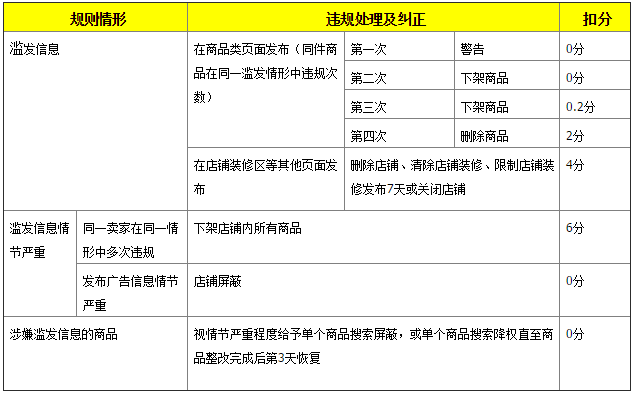
| 2. Situation Advertising information The information does not match the actual situation Repeat information Inconsistent product elements Avoid information Special industry requirements 3. Violation handling For specific methods of handling violations, please refer to the implementation rules for various circumstances of missed information. |
"Rules and Implementation Rules for the Identification and Punishment of Advertising Information" |
Before the change | After the change |
2. Situation 1. Publish products or information that are not for transaction purposes Including but not limited to: (1) Publish products or information that are not actually sold, such as mood stories, store introductions, appreciation only, contact information only, etc. as independent product pages; (2) Publish wholesale, agency, investment promotion, recycling, replacement, and purchase products or information outside the supply and marketing platform; (3) In addition to the friendly link module provided by Taobao customers and Taobao on the site, publish information on other Taobao stores, products, etc. besides this store. 2. Publish products or information from external websites that are prone to transaction risks For example, publish information such as social networking, shopping guides, group buying, promotions, shopping platforms, etc., such as the name, LOGO, QR code, hyperlink, contact account, etc. III. Case / 4. Violation handling 
| 2. Situation 1. Publish products or information that are not for transaction purposes Including but not limited to: (1) Publish products or information that are not actually sold, such as mood stories, store introductions, appreciation only, contact information only, etc. as independent product pages; (2) Publish wholesale, agency, investment promotion, recycling, replacement, purchase of goods or information outside the supply and marketing platform or designated categories ; (3) In addition to the friendly link module provided by Taobao customers and Taobao on the site, publish information on other Taobao stores, products, etc. besides this store. 2. Publish products or information from external websites that are prone to transaction risks For example, publish information such as social networking, shopping guides, group buying, promotions, shopping platforms, etc., such as the name, LOGO, QR code, hyperlink, contact account, etc. Unless otherwise agreed in specific markets (such as Red Mansions). III. Case Added advertising information case of "no actual price based products" 4. Violation handling 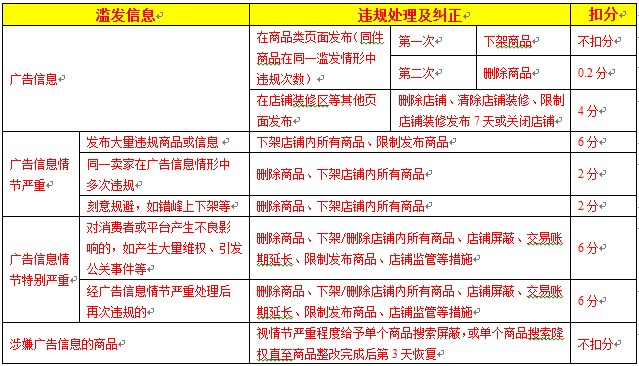
|
"Rules and Implementation Rules for the Determination and Punishment of Information and Inaction" |
Before the change | After the change |
2. Situation Including but not limited to: 1. Exaggerated, excessive or false promises of product effectiveness and degree 1 ) Exaggerated descriptions such as "highest, lowest, best, hottest" on the entire network 2 ) Promote the actual use effect of the product that does not match If the product actually has no effect but describes many effects when the product is released; or if the product is effective but exaggerates and over-describes the content and scope of the product's efficacy when the product is released; or if the product is effective but the product is released, it exaggerates and over-describes the content and scope of the product's efficacy when the product is released; 3 ) Other descriptions of exaggerated publicity 4. Violation handling 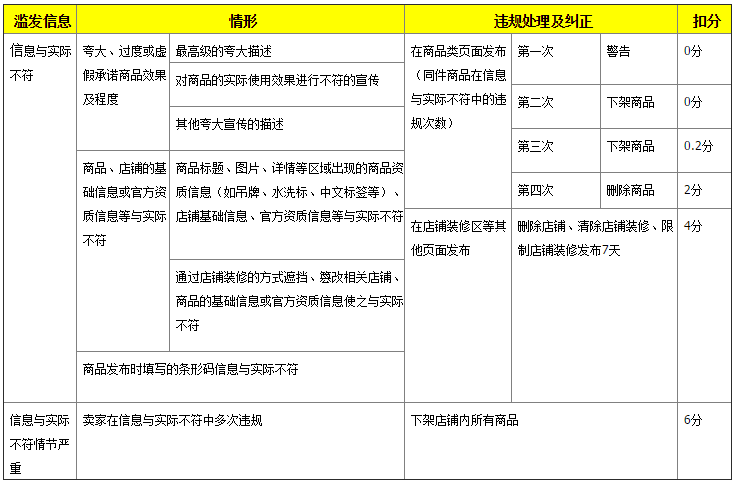
| 2. Situation Including but not limited to: 1. Exaggerated, excessive or false promises of product effectiveness and degree 1 ) Exaggerated descriptions using terms such as "national", "highest", and "best" 2 ) Promote false or misleading publicity on the quality, purpose, use effect, etc. of the product If the product actually has no effect but the product describes the effect when it is released; or the product has effect but the product exaggerates and over-describes the content and scope of the product's efficacy when it is released; or the product has effect but the product has exaggerated and over-described the content and scope of the product's efficacy when it is released; 3 ) Other descriptions of exaggerated publicity 4. Violation handling 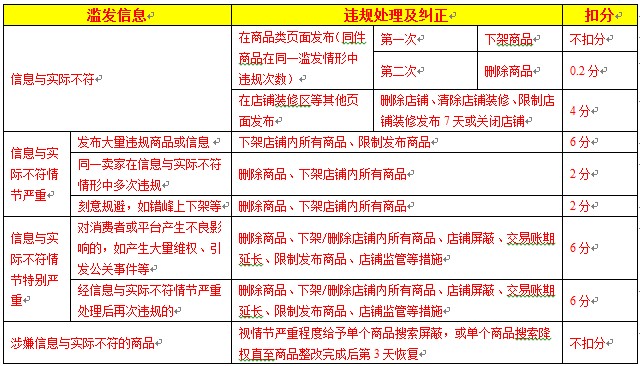
|
"Rules and Implementation Rules for the Determination and Punishment of Information Duplication" |
Before the change | After the change |
4. Violation handling 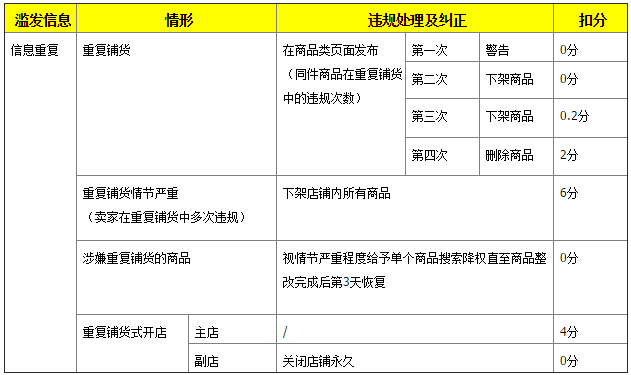
| 4. Violation handling
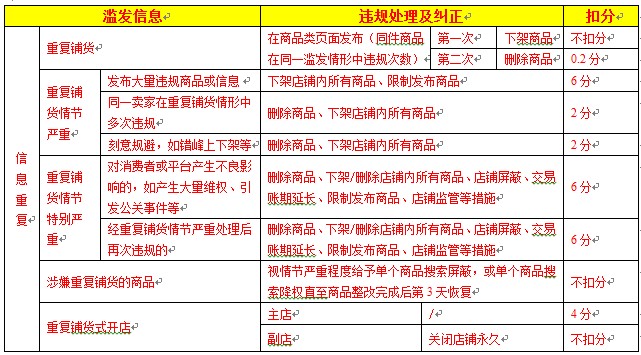 |
"Rules and Implementation Rules for the Determination and Punishment of Inconsistency in Commodity Elements" |
Before the change | After the change |
1. Definition Inconsistent product elements refer to the inconsistency of product information elements such as category (category), postage, attributes, marketing keywords, prices, freight templates, attributes , and types in the release of product pages (such as product titles, pictures, prices, freight templates, attributes, and other products). 2. Situation 1. Inconsistent categories 2. Baby types are inconsistent 3. Inconsistent attributes 4. Prices are inconsistent The price of the product described in the title, picture or details page of the product is inconsistent with the actual sales price . Case 1: A product title or detailed description or picture description is 30 yuan, but the actual sales price is 35 yuan. Case 2: The actual sales price and the marked product price are inconsistent with the actual sales price. 5. The postage is inconsistent 6. Inconsistent marketing keywords The marketing keywords in the product are inconsistent, such as the mutually exclusive marketing keywords such as "clearance" and "new products" appear in the product title at the same time. 4. Violation handling 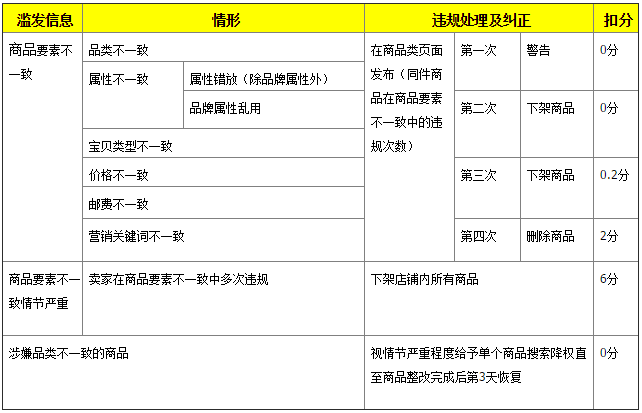
| 1. Definition Inconsistent product elements refer to the inconsistency of product information elements such as category (category), postage, attributes, price, price, and type in the release of product pages (such as product title, picture, price, and freight template, attributes area, detailed description, backend category, etc.). 2. Situation 1. Inconsistent categories 2. Baby types are inconsistent 3. Inconsistent attributes 4. Prices are inconsistent The price of the product described in the title, picture or details page of the product is inconsistent with the price of the product marked . Case 1: A product title or detailed description or picture description is 30 yuan, but the price of the product marked is 35 yuan. Case 2: The price description and price tagged with the product picture, title or details page are inconsistent with the price tagged with the price tagged with "Price change" and "Price reduction after auction" . 5. The postage is inconsistent 6. Inconsistent marketing keywords The marketing keywords in the product are inconsistent, such as the mutually exclusive marketing keywords such as "clearance" and "new products" appear in the product title at the same time. 4. Violation handling 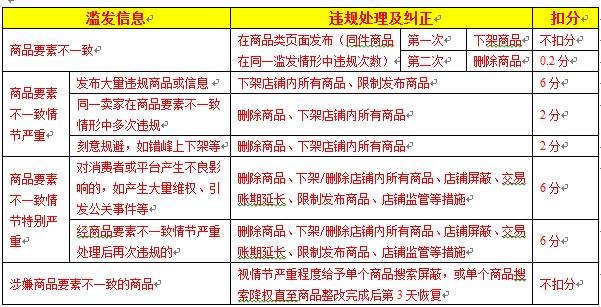
|
"Rules and Implementation Rules for the Identification and Punishment of Information" |
Before the change | After the change |
1. Definition Price cheating refers to members deliberately avoiding Taobao price setting rules and publishing products through various methods. 2. Situation Including but not limited to: 1. Use Sku to drive traffic at low prices 2. Publish products in unconventional units of quantity 3. The product postage deviates from the actual price 3. Violation handling 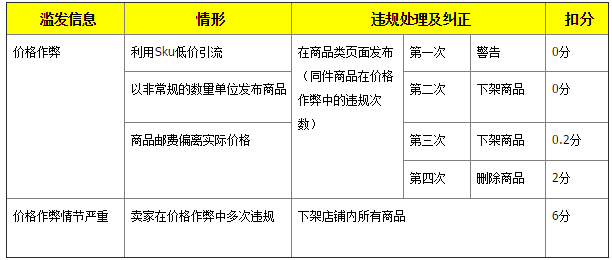
| 1. Definition Avoiding information means that members deliberately avoid the requirements of Taobao product release rules to publish products through various methods. 2. Situation Including but not limited to: 1. Use Sku to drive traffic at low prices 2. Publish products in unconventional units of quantity 3. The product postage deviates from the actual price 4. Changes to the product elements of another product by editing key attributes such as product category, brand, model, etc. 1) Modify product A into product B of completely different categories Case 1: The original product for sale was socks, and the product for sale was T-shirts. Case 2: The original product for sale was a night lamp, and the current product for sale was a crystal lamp. Case 3: The original product for sale was a cheating situation of SKU. The tissue and sofa were posted in a product ID, and the product for sale was a sofa. 2) Modify product A into product B with a completely different brand Case: The original product for sale was Nike's sneakers, but now the product for sale was Onitsuka Tiger's sneakers. 3) If the following situations occur for mobile phone products: Modify product A to product B of a completely different model, or replace the refurbished machine with a brand new machine. Case 1: The original product for sale was iPhone6, and the current product for sale was iPhone6s. Case 2: The original product for sale was Apple's official refurbished phone, and the product for sale is Apple's brand new phone. 3. Violation handling 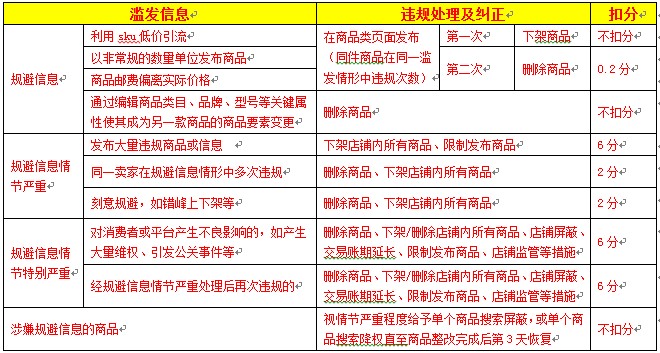
4. Warm reminder Increase: 3. Common judgment criteria for changes in commodity elements Based on the common sense of ordinary people, it becomes another product by editing the product's key attributes such as category, title, picture, detailed description, price, brand, model, etc. 4. The boundary between product element changes and other rules for mis-issuing information The core of product elements changes is the replacement action and the result of becoming another product after replacement. For examples of paper towels and sofas above: if the seller does not delete the "paper towel", the product is a SKU cheating in the mis-sending message; if the seller deletes the "paper towel", the product is a change in the product elements. |
"Rules and Implementation Rules for the Identification and Punishment of Special Requirements in the Industry" |
Before the change | After the change |
2. Situation Including but not limited to the following situations: 1. Special categories of goods lack physical pictures of the goods sold Also known as "the main picture is not a real shot", that is, the product picture is not a picture taken by a member based on the product itself. The real picture refers to the real picture of the product itself. Taobao currently only manages the main photos under the categories of women's clothing, men's clothing, maternity clothing, children's clothing and other clothing categories, as well as the main photos under the categories of live pets (cats, dogs). Case: The main picture of the women's clothing category is not a real shot. After the same style is merged, multiple sellers' products use the same main picture. 3. Violation handling 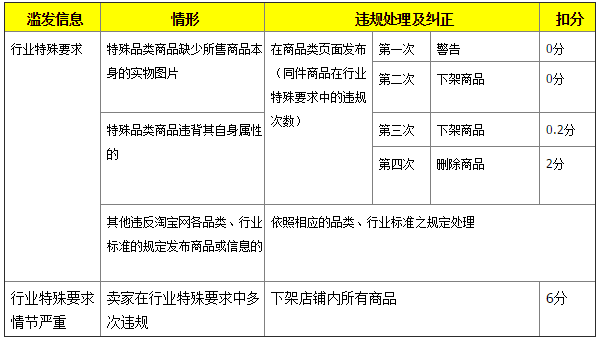
4. Warm reminder 1. Which pictures do not belong to real pictures? The real picture refers to the real picture of the product itself. The main picture of the product must be a real picture. The following situations are not considered physical pictures: pictures of other brands of items, official website pictures of the same style, magazine pictures, renderings published on other websites, or only text information in the main picture, etc. 5. Frequently Asked Questions 1. I sell women's clothing. How do I publish pictures to take real photos? Please use the product photos you took to publish the product, instead of directly using the data package pictures provided by the supplier, and do not obtain pictures you took to upload from other channels, so as not to be punished. | 2. Situation Including but not limited to the following situations: 1. Special categories of goods lack physical pictures of the goods sold themselves Also known as "the main picture is not a real shot", that is, the product picture is not a picture taken by a member based on the product itself. The real picture refers to the real picture of the product itself. Taobao currently only manages the main photos under the categories of women's clothing, men's clothing, maternity clothing, children's clothing and other clothing categories, as well as the main photos under the categories of live pets (cats, dogs). Case: The main picture of the women's clothing category is not a real shot. After the same style is merged, multiple sellers' products use the same main picture. 3. Violation handling 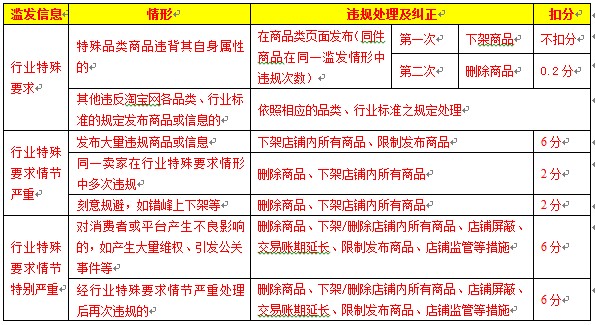
5. Warm reminder 1. Which pictures do not belong to real pictures? The real picture refers to the real picture of the product itself. The main picture of the product must be a real picture. The following situations are not considered physical pictures: pictures of other brands of items, official website pictures of the same style, magazine pictures, renderings published on other websites, or only text information in the main picture, etc. 5. Frequently Asked Questions 1. I sell women's clothing. How do I publish pictures to take real photos? Please use the product photos you took to publish the product, instead of directly using the data package pictures provided by the supplier, and do not obtain pictures you took to upload from other channels, so as not to be punished. |
"Rules and Implementation Rules for the Determination and Punishment of False Transactions" |
Before the change | After the change |
False transactions are carried out in the following forms:
1. Split a product into multiple different forms or pages to publish. Including but not limited to the following situations: the shipping costs of the goods and the goods are released separately; a baby is sold at different prices.
2. Pack up gifts for sale or use gifts to enhance credibility, etc.
3. Use a false delivery order number or one order number to repeatedly use it.
4. Change the product page information directly or indirectly, significantly modify the product price or product transaction price, etc.
5. Accumulate sales or popularity in the form of exchanging treasures. Including but not limited to: modifying the title, price, pictures, details, materials, etc. of the original baby to become another baby and continue to be sold.
6. Sellers limit the number of virtual items purchased by buyers. Including but not limited to: restricting a product to only purchase one ID; special regulations shall follow if otherwise specified in special markets.
7. Use a limited-time discount tool when publishing virtual products in three categories: Mobile/Universal Communications/Telecom Recharge Center, Online Game Card, and Tencent QQ Zone.
8. Other forms of false transactions. | False transactions are carried out in the following forms:
1. Split a product into multiple different forms or pages to publish. Including but not limited to the following situations: the shipping costs of the goods and the goods are released separately; a baby is sold at different prices.
2. Pack up gifts for sale or use gifts to enhance credibility, etc.
3. Use a false delivery order number or one order number to repeatedly use it.
4. Change the product page information directly or indirectly, significantly modify the product price or product transaction price, etc.
5. Accumulate sales or popularity in the form of exchanging treasures. Including but not limited to: modifying the title, price, pictures, details, materials, etc. of the original baby to become another baby and continue to be sold. 5. Sellers limit the number of virtual items purchased by buyers . Including but not limited to: restricting a product to only purchase one ID; special regulations shall follow if otherwise specified in special markets.
6. Use limited - time discount tools when publishing virtual products in three categories: Mobile/Unicom/ Telecom Recharge Center, Online Game Card, and Tencent QQ Zone.
7. Other forms of false transactions. |















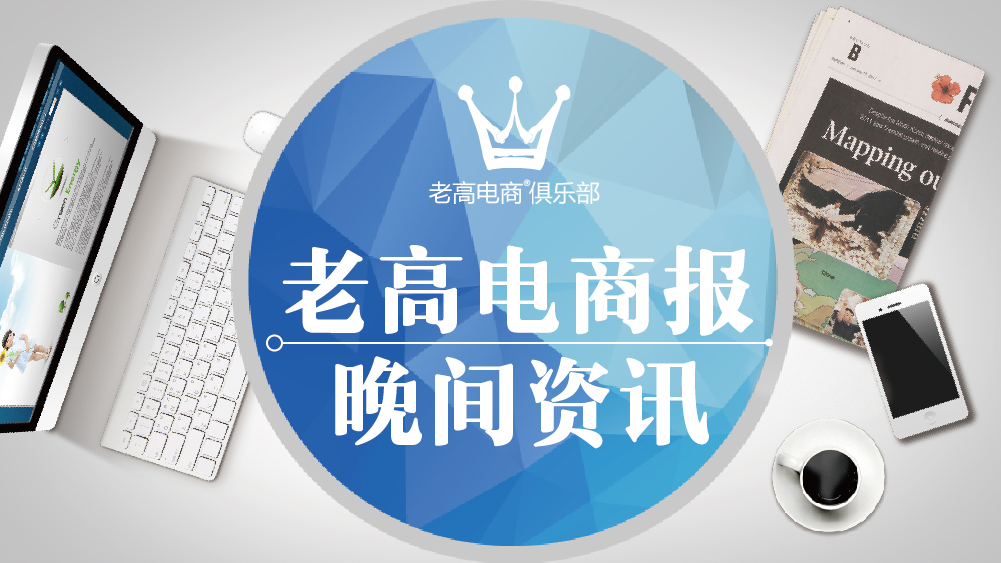
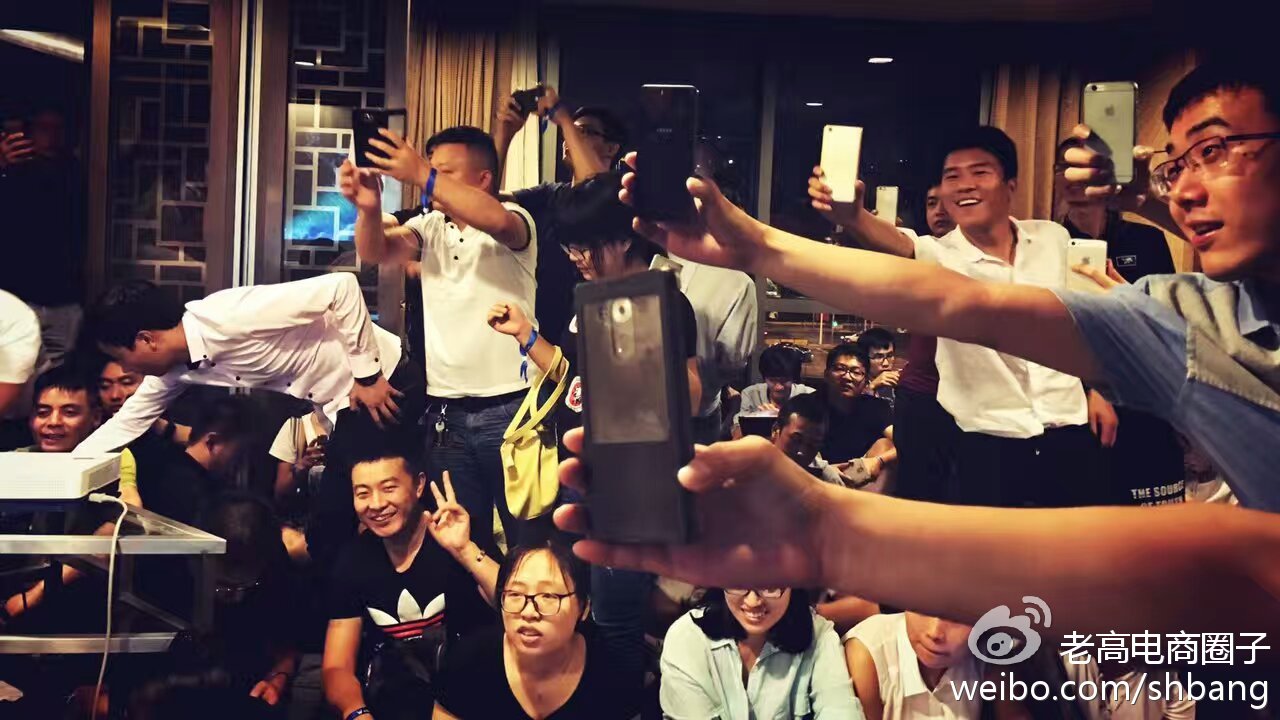
![#Laogao E-commerce Newsletter# [March 27 E-commerce Morning News]](/update/1679879852l532605238.jpg)

 EN
EN CN
CN
